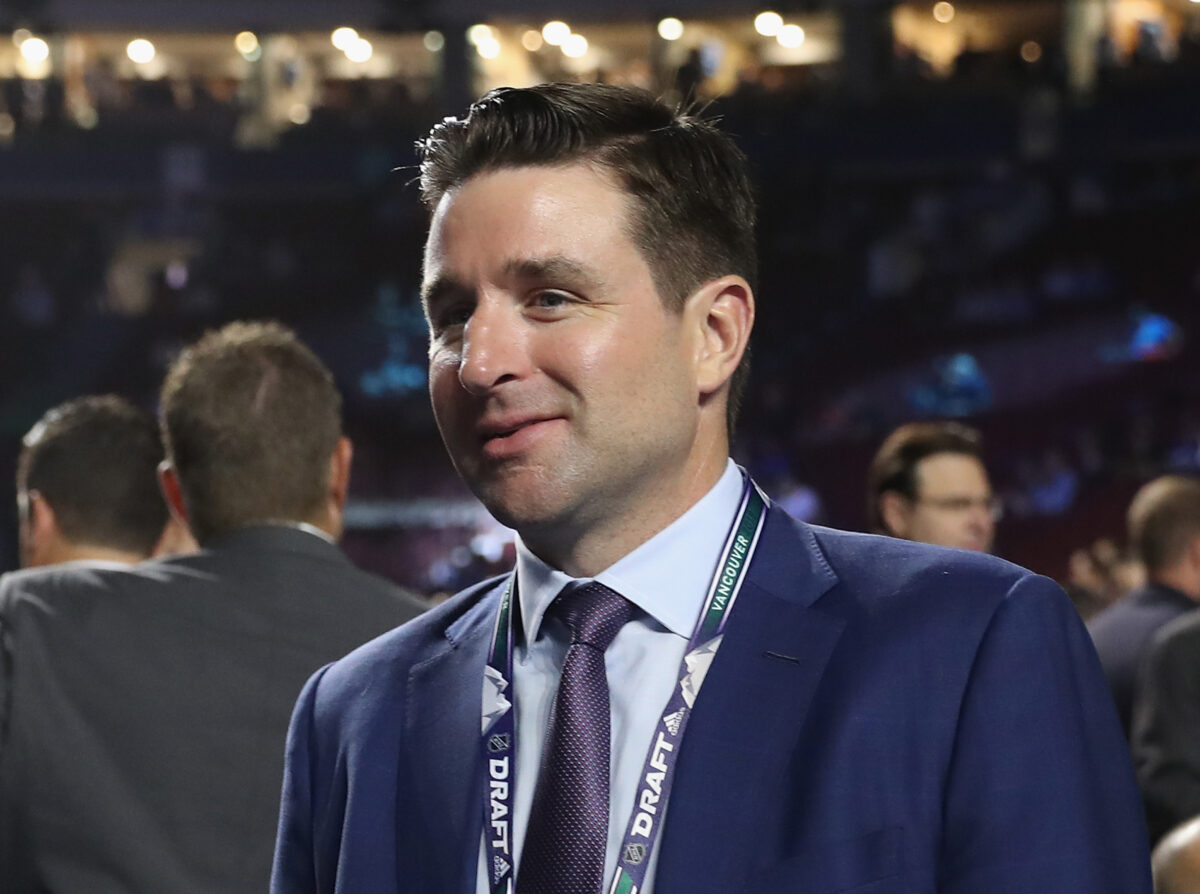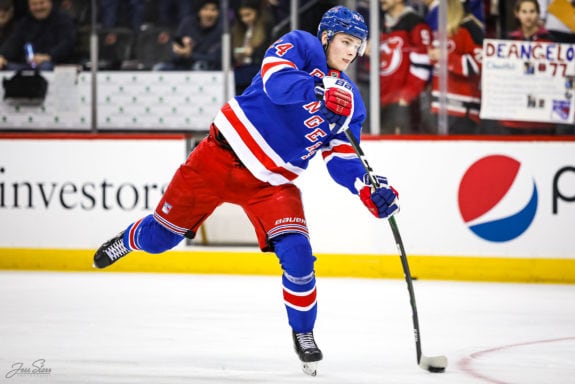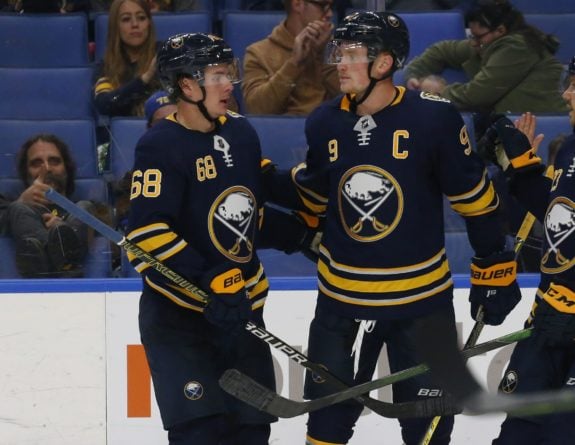When the New York Rangers selected Kaapo Kakko with the second-overall pick in 2019, there were quite high expectations for the young forward. He was coming off a big year in Finland where he scored 22 goals and 38 points in 45 games for his men’s club TPS. This made his draft stock go much higher than the previous year, and as the seasons have come and gone, he just hasn’t lived up to the hype. Perhaps the time has come for the Rangers to trade their struggling young forward while there is still some solid potential left, and gain back some future, with a little bit of scoring now.
The Buffalo Sabres have a number of young, struggling forwards, but one that stands out compared to the rest of them is Victor Olofsson. The former seventh-round pick in 2014 has made a name for himself with his big one-timer shot, and his power-play production in his first few seasons. Those numbers have gotten away from him this season, unfortunately. It makes sense that with all the young talent the Sabres have in the minors, that they will not have room for everyone, and as Olofsson’s scoring problems continue, he may be the odd man out considering his age (26).

Should both teams see fit to work something out, there could be an increase in production for both players moving forward. Many times, players have breakout sessions when the scenery changes, and their new team complements them in ways that the previous one could not. Just look at Sam Bennett of the Florida Panthers after he was traded away from the Calgary Flames; his production is higher than it’s ever been, and he is now in a system that allows him to produce better than ever before.
If this type of trade were to happen, the Rangers would be giving up Kakko and perhaps a low mid-round pick to go with him. For Buffalo, however, in order to have Rangers general manager (GM) Chris Drury not hang up immediately, they will need to offer more than just Olofsson.
The Rangers’ Assets
Kakko has played a total of 151 games and has amassed a total of 54 points (24 goals, 30 assists). In that span of time, he is also a minus-16. While he has played for the Rangers, he has not had a lot of significant time spent in the top six for their forward group, but prior to his injury sustained this year, he was seeing decent time with the top Rangers players — showing flashes of his scoring touch here and there. While the numbers are not impressive, he still makes a lot of good plays.
Due to his age (21), his draft pedigree is still valid. Young players take a little longer to develop and produce in the NHL these days. Jack Hughes, is an excellent example. In his first two seasons in the league, he only amassed 18 goals and 52 points in 117 games, and is now having a huge breakout with 16 goals and 38 points in 33 games. Seeing as both these players came from the same draft, their starts were similar, but their development has not been.

Kakko has the tools to be a productive power forward in the NHL — someone I would compare realistically to
Gabriel Landeskog of the Colorado Avalanche if he reaches his potential. He has a nose for the net, good scoring touch, and some creativity to go along with it. While the Rangers have an impressive record (35-15-5), being there doesn’t seem to be the right fit for him, but a smaller market with a young, growing team might work better.
The Sabres’ Assets
Olofsson is a great example of a low-round pick who develops the right way. He had plenty of time to figure out what he was really good at, and hone that skill into something viable in the NHL. That skill is undoubtedly his shot, especially his one-timer. The Sabres brought him up to play from the minors after he put up some great numbers in the American Hockey League (AHL). Olofsson scored 30 goals and 63 points in 66 games, and that was enough for him to earn a spot right on now former captain Jack Eichel‘s wing. He took the opportunity and ran with it showing he can finish the chances that Eichel made happen for him.
This has always been his weakness. He has the ability to finish a play off when he shoots with confidence, but he does not have many examples of creating plays for other people. His career totals are better than Kakko so far, and they have been in the league for the same number of seasons. Olofsson has collected 44 goals and 104 points in 162 games. He has 10 more games played than Kakko, but almost double his point totals. Where this balances out is the age difference, so Olofsson loses some value here towards the trade.

(THE CANADIAN PRESS/AP/Jeffrey T. Barnes)
The Sabres would also need to send another young player or a high draft pick if they were to make this swap with the Rangers. They would have to move a player like Casey Mittelstadt along with second- or third-round pick, or a good profile prospect like Jack Quinn or JJ Peterka. Seeing as Kevyn Adams is unlikely to part with his top two budding prospects for an underperforming player, Mittelstadt would be the more likely option. The Sabres’ young center has had some injury trouble, but showed some great flashes of brilliance last season. He was poised to take the No. 1 center role at the season’s start, but that position has been dominantly taken over by Tage Thompson. Mittelstadt possesses both playmaking and finishing ability, and he can provide it in a big role for the Rangers. If Ryan Strome does not return during the offseason, the Rangers will be looking for a second-line center; a role Mittelstadt can fill for them easily.
The Trade Options
The Rangers have been particularly stubborn with who they are willing to trade these days, but their development staff does not seem to be cutting it, either. Making a move for players that have developed might treat their organization better.
The Sabres are facing some tough choices when it comes to young players and future roster spots. Moving out an “older” player like Olofsson along with another player would clear up a little room.
The trade could be formulated a few ways, but an offer based on talent and performance of each player would look like this. Buffalo would trade Olofsson and Mittelstadt along with a second-round pick in this year’s draft to the Rangers for Kakko and a third-round pick.
Related – Okposo Has Become a Trade Asset In Bounceback Season
In this scenario, Buffalo is trading for the potential of Kakko to become the player he was drafted to be, and the Rangers get pieces they can insert immediately into their lineup, and will have the ability to produce on a regular basis. Kakko is still injured, so Buffalo would have to wait for his debut. Seeing as they have a poor record, this will not affect them terribly. Olofsson could step right in to a scoring role for the Rangers and be a threat on the right side for their power play to complement Artemi Panarin on the left. They would have two great one-timer options as Adam Fox would be running the point. Panarin is a star playmaker and scorer, so he would function as Olofsson’s “new Eichel” in a sense.
Struggling players tend to cause trade rumors when they have high draft stock or proven scoring ability. In this case, it would be very interesting to see how a trade between the Sabres and Rangers would actually play out if Olofsson and Kakko were at the center of it all.
